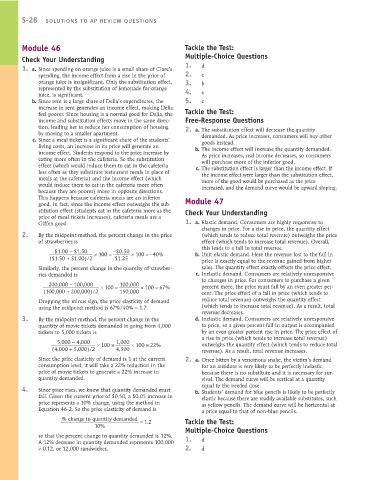Page 874 - Krugmans Economics for AP Text Book_Neat
P. 874
S-28 SOLUTIONS TO AP REVIEW QUESTIONS
Module 46 Tackle the Test:
Check Your Understanding Multiple-Choice Questions
1. d
1. a. Since spending on orange juice is a small share of Clare’s
spending, the income effect from a rise in the price of 2. c
orange juice is insignificant. Only the substitution effect, 3. b
represented by the substitution of lemonade for orange 4.
juice, is significant. e
b. Since rent is a large share of Delia’s expenditures, the 5. c
increase in rent generates an income effect, making Delia Tackle the Test:
feel poorer. Since housing is a normal good for Delia, the
income and substitution effects move in the same direc- Free-Response Questions
tion, leading her to reduce her consumption of housing 2. a. The substitution effect will decrease the quantity
by moving to a smaller apartment. demanded. As price increases, consumers will buy other
c. Since a meal ticket is a significant share of the students’ goods instead.
living costs, an increase in its price will generate an b. The income effect will increase the quantity demanded.
income effect. Students respond to the price increase by As price increases, real income decreases, so consumers
eating more often in the cafeteria. So the substitution will purchase more of the inferior good.
effect (which would induce them to eat in the cafeteria c. The substitution effect is larger than the income effect. If
less often as they substitute restaurant meals in place of the income effect were larger than the substitution effect,
meals at the cafeteria) and the income effect (which more of the good would be purchased as the price
would induce them to eat in the cafeteria more often increased, and the demand curve would be upward sloping.
because they are poorer) move in opposite directions.
This happens because cafeteria meals are an inferior Module 47
good. In fact, since the income effect outweighs the sub-
stitution effect (students eat in the cafeteria more as the Check Your Understanding
price of meal tickets increases), cafeteria meals are a
Giffen good. 1. a. Elastic demand. Consumers are highly responsive to
changes in price. For a rise in price, the quantity effect
2. By the midpoint method, the percent change in the price (which tends to reduce total revenue) outweighs the price
of strawberries is effect (which tends to increase total revenue). Overall,
this leads to a fall in total revenue.
$1.00 − $1.50 × 100 = −$0.50 × 100 = −40% b. Unit-elastic demand. Here the revenue lost to the fall in
($1.50 + $1.00)/2 $1.25
price is exactly equal to the revenue gained from higher
Similarly, the percent change in the quantity of strawber- sales. The quantity effect exactly offsets the price effect.
ries demanded is c. Inelastic demand. Consumers are relatively unresponsive
to changes in price. For consumers to purchase a given
200,000 − 100,000 × 100 = 100,000 × 100 = 67% percent more, the price must fall by an even greater per-
(100,000 + 200,000)/2 150,000 cent. The price effect of a fall in price (which tends to
Dropping the minus sign, the price elasticity of demand reduce total revenue) outweighs the quantity effect
using the midpoint method is 67%/40% = 1.7. (which tends to increase total revenue). As a result, total
revenue decreases.
3. By the midpoint method, the percent change in the d. Inelastic demand. Consumers are relatively unresponsive
quantity of movie tickets demanded in going from 4,000 to price, so a given percent fall in output is accompanied
tickets to 5,000 tickets is by an even greater percent rise in price. The price effect of
a rise in price (which tends to increase total revenue)
5,000 − 4,000 × 100 = 1,000 × 100 = 22% outweighs the quantity effect (which tends to reduce total
(4,000 + 5,000)/2 4,500 revenue). As a result, total revenue increases.
Since the price elasticity of demand is 1 at the current 2. a. Once bitten by a venomous snake, the victim’s demand
consumption level, it will take a 22% reduction in the for an antidote is very likely to be perfectly inelastic
price of movie tickets to generate a 22% increase in because there is no substitute and it is necessary for sur-
quantity demanded. vival. The demand curve will be vertical at a quantity
equal to the needed dose.
4. Since price rises, we know that quantity demanded must b. Students’ demand for blue pencils is likely to be perfectly
fall. Given the current price of $0.50, a $0.05 increase in elastic because there are readily available substitutes, such
price represents a 10% change, using the method in as yellow pencils. The demand curve will be horizontal at
Equation 46-2. So the price elasticity of demand is a price equal to that of non-blue pencils.
% change in quantity demanded
= 1.2 Tackle the Test:
10%
Multiple-Choice Questions
so that the percent change in quantity demanded is 12%. 1.
A 12% decrease in quantity demanded represents 100,000 d
× 0.12, or 12,000 sandwiches. 2. d

